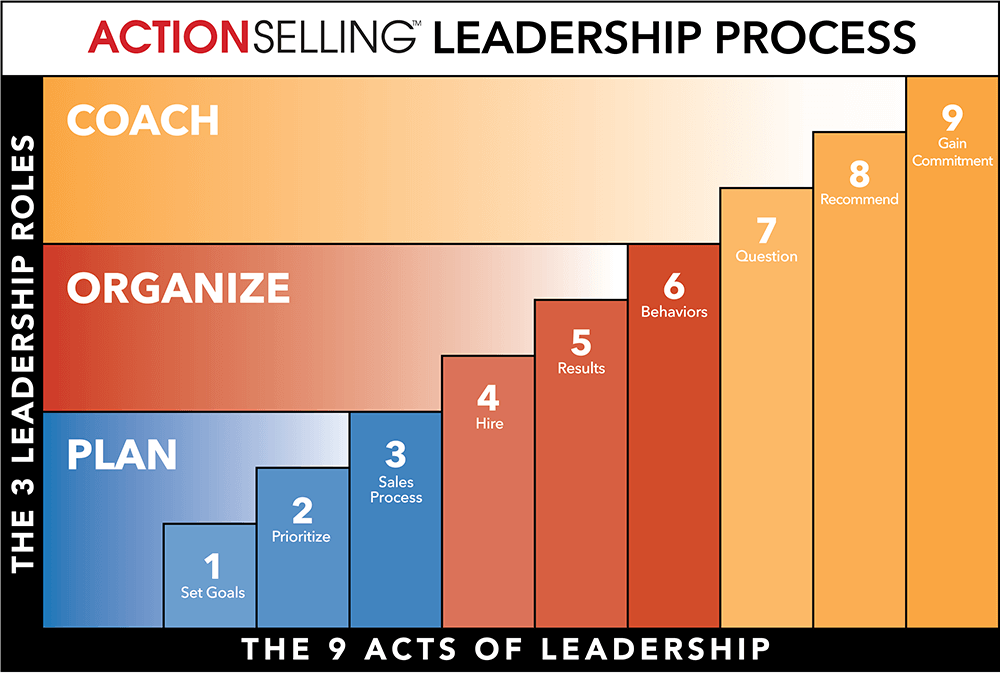
A WORD FROM DUANE SPARKS
Dear Sales Executive:
When you think of management systems designed to promote continuous improvement—TQM, Six Sigma, Kaizen—what key feature do they have in common? They all concentrate on processes, right?
Sales leadership also can be viewed as a set of processes. And, when we look at it that way, wonderful things can happen. Let me elaborate.
If you have a question about how to build a great sales culture—and then keep on making make it better, click on “Ask The eCoach“.
We are committed to your professional success.
Duane Sparks Author of Action Selling ®
Six Critical Processes for Sales Leaders

Six Critical Processes for Sales Leaders
The primary role of all sales leaders is to deliver profitable revenue to the company. As the best management thinkers have long recognized, the key to achieving any such goal successfully is to put the right processes in place.
The primary role of all sales leaders is to deliver profitable revenue to the company. As the best management thinkers have long recognized, the key to achieving any such goal successfully is to put the right processes in place.

We will dive deeper into that diagram in upcoming editions of eCoach. First, however, let me point out something fundamental to this whole discussion. While processes are the key to continuous improvement, not all processes are critical. It isn’t just a question of managing processes; it’s all about managing the right processes. The most important ones are those that are executed often, have a direct link to individual sales performance, and underlie business growth.
It’s all about managing the right processes.
I believe that six sales leadership processes qualify as critical.
The 6 Critical Sales Leadership Processes
- Goal Setting Process
- Sales Cycle Process
- Hiring Process
- Process for Measuring Results
- Sales Call Process
- Sales Coaching Process
Because most of these processes are performed repeatedly, small improvements in them can add up to huge benefits. Take your sales-cycle process, for example. A tweak in how well salespeople orchestrate their sales activities can get you significantly more sales, a sizable acceleration in sales-cycle velocity, and an improvement in gross margins. Fine-tuning your sales-cycle process can produce big gains as small improvements are consistently applied.
Another example is the hiring process. We’ve all heard how expensive a hiring mistake can be (50% to 75% of the employee’s annual income). Small changes to your hiring approach can dramatically reduce these costly errors, allowing you to add more value to the organization and continually improve outcomes.
Likewise, the other four critical processes represent pressure points where relatively small actions can produce enormous results.
Goal setting process: A sales team without specific goals cannot be successful. As a sales leader, you’ll need to communicate goals, priorities, and processes that are linked to your company’s strategy in an optimal way. Most sales goals are financial, but others might involve matters such as closing ratios, reductions in sales-cycle time, and more.
Process for measuring results: Sales numbers don’t lie. Nothing else you do matters if the numbers aren’t hit. It is your job to communicate to the team what’s expected. Identify the Key Performance Indicators that are most important, and make sure everyone knows where they stand. When you do this, you are creating a results-based culture.
Sales call process: Use the Action Selling ® system to orchestrate successful sales interactions with customers and prospects. How well does everyone master and follow the system? The answer gives you a quality measure of each salesperson in your organization and each sales call that they make.
Sales coaching process: Coaching your salespeople, as opposed to simply “managing” them, allows you to accomplish a number of desirable goals. You are able to pinpoint performance problems and understand their causes. Therefore, you are better able to prescribe solutions that address real core issues. Such solutions are far more likely to work.
Those six processes operate within the larger sales-leadership process to create a virtuous cycle of continuous improvement. And, that’s what builds a great sales culture.
Our latest free white paper describes the most successful way to develop great sales leaders and a great sales culture. Download it here: Unhappy with Your Sales Culture? (Start With an Overhaul of Your Sales Leadership Process)
Action Selling ® in Action
Take, for example, your sales call process and your sales cycle process. When you focus on these processes properly and consistently to provide direction on the quality and quantity of sales activities, you are instilling a certain culture. That culture is based on the particular sales behaviors that have the best chance of leading salespeople toward success. (The Action Selling ® system is built upon those particular behaviors.)
Therefore, these processes define what success looks like—and they define it correctly. Sales leaders who maintain this focus create a sales culture that is always moving in the right direction. Why? Because they are following the right map.
For information about how to make sales training pay huge dividends, contact Action Selling ® at (800) 232-3485.
For a more complete description of the most successful way to develop great sales leaders and a great sales culture, get our latest white paper: Unhappy with Your Sales Culture? (Start With an Overhaul of Your Sales Leadership Process)
Recent eCoaches
Don’t Look Now, But Your Sales Culture Gap is Growing
Close Your Culture Gap! Align Sales and Service
Why 64% of Salespeople Don’t Close
Stalls Vs. Objections: No, They Don’t Have the Same Solution
No Detours! Why Must You Leave the Sales Path Just to Handle an Objection?
I Object! (To the Way You Define Objections)
How to Train Your Way Out of a Sales Slump
It’s Not What You Sell, It’s How You Sell
How Do You Know If Your Sales Force Is Good?
“One Call” Close Not Dead Yet?
TQM for Sales Leadership? Yes!
Six Critical Processes for Sales Leaders
10 Great Ideas About Sales Leadership
The Three Core Roles of Every Sales Leader
The Nine Acts of Sales Leadership
5 Secrets to Record-Breaking Sales
Sales Training That Actually Works
The Sales Leader’s Toughest Challenge
How Strong is Your Sales Culture?
Want to Create the Best Sales Culture?


ASSESS YOUR SALES SKILLS
Unlock your hidden sales potential today – take our free Selling Skills Assessment.

THE NEW ACTION SELLING
A Quick Read That Will Boost Your Sales — Guaranteed!

